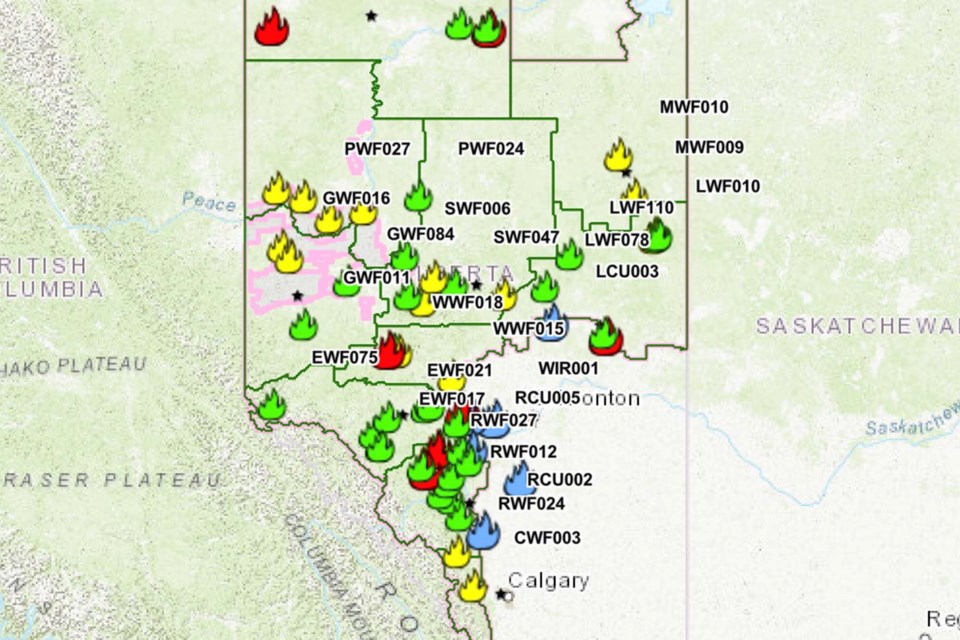The number of Alberta wildfires has nearly doubled this year compared to the five-year average.
Data from the wildfire status dashboard current from May 4, 2 p.m. showed there were 64 active wildfires in the province for a total of 323 wildfires this year.
The five-year average on wildfires is 166, said Derrick Forsythe, wildfire information officer at Alberta Wildfire.
Forsythe said 1002 hectares have burned so far this year and with the five-year average of hectares lost sitting at 400.17, it’s been a busy wildfire season.
“Today we're at 102.11 (hectares). We're up almost 600 hectares over the five-year average of where we were last year. That’s more than double what we were in the five-year average in terms of hectares burned,” he said.
Forsythe said those numbers do not include the current wildfire of note that Alberta Wildfire is assisting with in Yellowhead County approximately 7 km northwest of Evansburg on both sides of Highway 22, 3 km north of Highway 16, nor did those numbers include the Parkland County wildfire located 7 km southeast of Entwistle which is being held and as of May 3, is no longer a wildfire of note.
According to the Yellowhead County Facebook page, on April 29, Yellowhead County issued an evacuation order for the Hamlet of Evansburg. The evacuation order expanded to include Lobstick and north of Wildwood on April 30, and on May 1 the evacuation order was expanded to include Wildwood and area.
Parkland County issued an evacuation order for Entwistle and Range Road 65 to the Pembina River, north of Township Road 530 to Hwy 16 on April 29, according to a Parkland County Facebook post.
Evacuation orders were lifted on May 2 for Evansburg, Entwistle, and areas in Parkland County and on May 3 for residents in the Wildwood/Lobstick area.
Residents in the Wildwood area remained on a 30-minute alert, according to a Yellowhead County Facebook post from May 3.
As of May 3, data from Alberta Wildfire showed the fire in Yellowhead County was 2,320 hectares in size. A fire guard had been established around 75 per cent of the wildfire while the remaining 25 per cent was being controlled by aircraft and crews.
There were 75 wildland firefighters, six helicopters, and seven pieces of heavy equipment assigned to fight the wildfire.
An active wildfire also remains in Leduc County although the fire is contained evacuation orders are still in effect for everyone located on Range Road 24 between Township Road 474 and Township Road 475, as of May 3.
Forsythe said the season started earlier this year and we haven’t seen a lot of moisture in Alberta, that coupled with warmer than normal temperatures, wind and dried fuel means the fire danger ranges can climb rapidly.
“Spring is our most volatile time for wildfire because there's so much dead and dry fuel all over the landscape and the older grasses has died off from the year before. It hasn't recovered. It takes very little to ignite that as a fuel and if it's windy, it will run quickly over the landscape,” Forsythe said.
Most of the fires, said Forsythe, are only three to four days old now and they can’t say what caused them yet, but there are two basic causes of wildfire in Alberta: lightning and human caused fire.
“And in the springtime, we don't normally see a lot of lightning,” he said.
Last year 61 per cent of all wildfires in Alberta were human caused. The number has been trending down, said Forsythe, but there is still room for improvement.
He said Alberta Wildfire is asking people to be careful with their campfires and soak them when they are leaving, stir up the ashes, soak them again and make sure they are almost cool to the touch.
“Then a lot of people in Alberta love to go off highway vehicle driving, you know, quads and things like that, and bikes, and we asked them in those people who are engaged in that activity to stop regularly when they're traveling through off road and check the hotspots on the vehicle the mufflers and the manifolds because grass can sometimes build up there,” he said.
If the grass ignites and drops off it can spark the grasses on the ground, he continued.
“It's little things, but those little things can make a big difference in terms of reducing the wildfire risk across the province,” he said.
Overall, Forsythe said he would like to see some help from mother nature,
“In terms of precipitation and even a cooling of temperatures and return of higher humidity levels that also help to mitigate the threat of fire,” he said.
Fire bans, restrictions, and advisories are in place in jurisdictions across the province and information about current fire advisory status can be found on municipal websites, the Alberta Parks website, or the Alberta Wildfire website.
Emergency alerts can be found on the Alberta Emergency Alert webpage.




